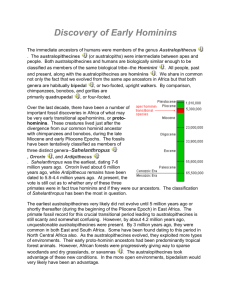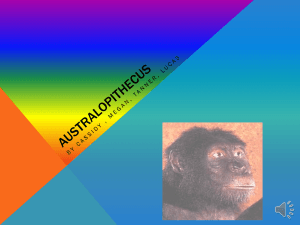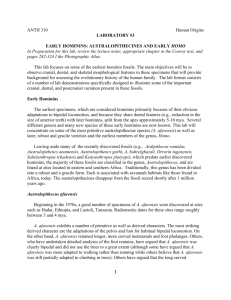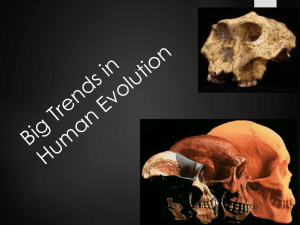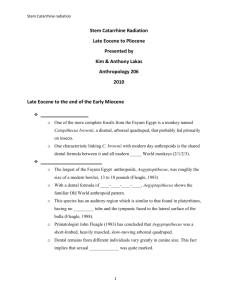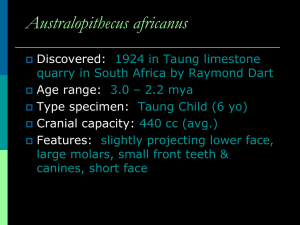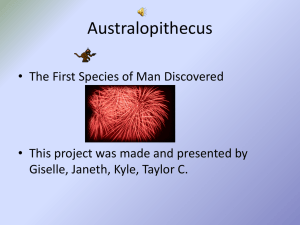Analysis of Early Hominins
advertisement
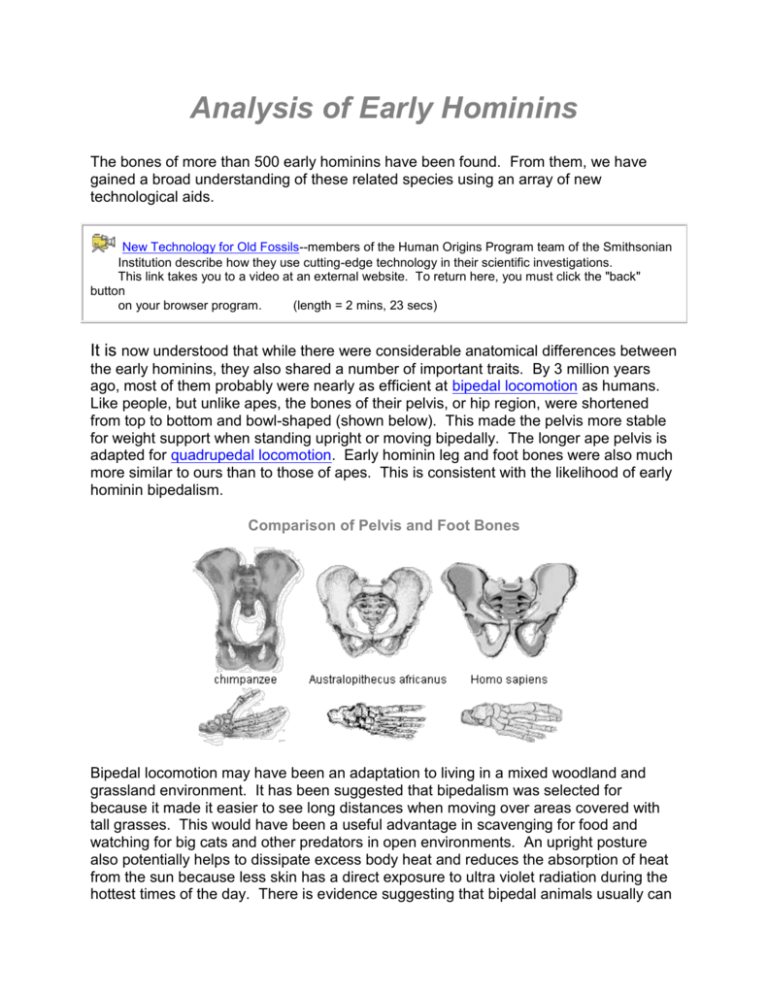
Analysis of Early Hominins The bones of more than 500 early hominins have been found. From them, we have gained a broad understanding of these related species using an array of new technological aids. New Technology for Old Fossils--members of the Human Origins Program team of the Smithsonian Institution describe how they use cutting-edge technology in their scientific investigations. This link takes you to a video at an external website. To return here, you must click the "back" button on your browser program. (length = 2 mins, 23 secs) It is now understood that while there were considerable anatomical differences between the early hominins, they also shared a number of important traits. By 3 million years ago, most of them probably were nearly as efficient at bipedal locomotion as humans. Like people, but unlike apes, the bones of their pelvis, or hip region, were shortened from top to bottom and bowl-shaped (shown below). This made the pelvis more stable for weight support when standing upright or moving bipedally. The longer ape pelvis is adapted for quadrupedal locomotion. Early hominin leg and foot bones were also much more similar to ours than to those of apes. This is consistent with the likelihood of early hominin bipedalism. Comparison of Pelvis and Foot Bones Bipedal locomotion may have been an adaptation to living in a mixed woodland and grassland environment. It has been suggested that bipedalism was selected for because it made it easier to see long distances when moving over areas covered with tall grasses. This would have been a useful advantage in scavenging for food and watching for big cats and other predators in open environments. An upright posture also potentially helps to dissipate excess body heat and reduces the absorption of heat from the sun because less skin has a direct exposure to ultra violet radiation during the hottest times of the day. There is evidence suggesting that bipedal animals usually can walk greater distances because less energy is expended with their longer strides. This would be useful for scavenging for food throughout vast areas. However, the legs of bipedal animals need to be sturdy enough to support at least 2.5 times their body weight while running. Over many generations, early hominin legs became longer and much stronger than their arms. Their feet developed arches for more efficient support of their bodies. In addition, their hands became more adept at carrying and manipulating objects such as tools and food. These adaptations to walking bipedally on the ground made it progressively more difficult to climb and travel through the canopies of trees. Walking Tall--a comparison between human and chimpanzee skeletons This link takes you to a video at an external website. To return here, you must click the "back" button on your browser program. (length = 56 secs) Baby Steps: Learning to Walk, The Hominid Way--the evolution of bipedalism among our hominid ancestors. This link takes you to an audio file at an external website. To return here, you must click the "back" button on your browser program. (length = 7 mins, 46 secs) Chimpanzees and all of the other apes have longer arms than legs and lack arches on the bottoms of their feet. In addition, their big toes are divergent from their other toes much like human thumbs. While the late australopithecines were similar to humans anatomically below the neck, their heads were significantly different from ours in several key features. Their adult brain size was about 1/3 that of people today. As a result, the widest part of the skull of these early hominins was below the brain case. For modern humans, it usually is in the temple region. Early hominin faces were large relative to the size of their brain cases. They had comparatively big teeth with thick enamel, large jaws, and powerful jaw muscles. The size and shape of these muscles is indicated by flaring zygomatic arches , or cheek bones, behind which the jaw muscles pass and the presence of a sagittal crest , which is a jaw muscle attachment ridge of bone on top of the skull in the robust species. In modern humans, the jaw muscles are much smaller and attach onto the skull in the temple region. From the side view, early hominin faces were concave or dish-shaped and projecting forward at the bottom due to their relatively small brain cases and huge teeth and jaws. In contrast, our jaws are relatively small and our faces are nearly vertical. Australopithecus boisei Modern human NOTE: When the lower portion of the face markedly projects forward (as in the case of the australopithecines), it is known as prognathism. Australopithecine and other early hominin fossils have been found only in Africa. The majority of them were discovered in East and South Africa. However, some also were found in Chad, which is located in North Central Africa. Current evidence indicates that there were as many as 12 species of early hominins between 6 and 1.5 million years ago, but they did not all live at the same time. The following species are the most widely accepted ones: 1. Australopithecus anamensis 2. Australopithecus afarensis 3. Australopithecus africanus 4. Australopithecus aethiopicus (or Paranthropus aethiopicus) 5. Australopithecus boisei (or Paranthropus boisei) 6. Australopithecus robustus (or Paranthropus robustus) The fossil record of early hominins is being added to by new important discoveries almost every year. As a result, it is not yet clear how many species of them actually existed nor is it certain what their evolutionary relationship was to each other. However, the broad outlines of this complex evolutionary history are already known and are summarized here. To see a more complete listing of proposed species of early hominins and their immediate ancestors, select the button below. It would be helpful to have a printout of this table in order to understand the discussion of the early hominins that follows. Table of Early Hominins and Their Immediate Ancestors Early Australopithecine Species Australopithecus anamensis may have been the earliest australopithecine species. They lived about 4.2-3.9 million years ago in East Africa. Unfortunately, little is known about them due to the scarcity of their fossils and the fact that the ones that have been found are highly fragmentary. This species apparently was descended fromArdipithecus ramidus, which lived around 4.4 million years ago, or an even earlier ape/hominin transitional species near the beginning of the Pliocene Epoch. Anamensis was bipedal but may still have been an efficient tree climber. The shapes of the arm and leg bones indicate that it was bipedal. The canine teeth are relatively large compared to later australopithecines and humans. The alignment of teeth in the jaw is somewhat rectangular, reminiscent of apes, rather than like the modern human parabolic dental arch (like the McDonald's golden arches sign). Anamensis remains have been found in what had been woodlands around lakes. Their diets were apparently mainly vegetarian with an emphasis on fruits and nuts. Australopithecus afarensis lived about 3.7-3.0 million years ago in East Africa. Skeletally, they were still somewhat transitional from earlier ape species. This can be seen in their legs which were relatively shorter than those of the later australopithecines and humans. Afarensis also had slender curved fingers reminiscent of chimpanzees. Because of these anatomical characteristics, it has been suggested that they were less efficient bipeds and more efficient tree climbers than the later australopithecines. Afarensis canine teeth were relatively large and pointed, reminiscent of apes. They projected somewhat beyond their other teeth but not as much as in chimpanzees. Some of the male afarensis had small sagittal crests. Australopithecus afarensis (Lucy) Kenyanthropus platyops (reconstructed appearance) Australopithecus afarensis (reconstructed appearance) Tim White and some other paleoanthropologists believe that there was considerable physical variation within the species Australopithecus afarensis. They suggest that the recently discovered fossils classified as Kenyanthropus platyops (3.5-3.2 million years ago) was a variant form of afarensis but with somewhat smaller teeth. White discounts the flattened face of platyops as being due to the deformation of the bones by ground pressure after death. Its discoverer, Meave Leakey, disagrees. She believes that platyops was a separate species and that it was more likely to have been the progenitor of humans. Additional hominin fossils from the crucial time period of 4-3 million years ago must be discovered to conclusively determine the place of platyops in our evolution. Australopithecus africanus lived about 3.3-2.5 million years ago in South and East Africa. Skeletally, they were less apelike than earlier species of australopithecines but were still usually small and light in frame like afarensis. However, the teeth of africanus were in some ways more like humans than like afarensis. Specifically, the front teeth of africanuswere relatively large like ours and their canine teeth did not project beyond the others. Microscopic wear patterns Australopithecus africanus onafricanus teeth suggest a diet consisting of relatively soft foods, which very likely included some meat along with plants. This does not necessarily imply efficient hunting skills. More likely, they obtained meat by scavenging what remained on the abandoned corpses of large animals killed by lions and other predators. It is possible that they also did some hunting of small animals in much the same inefficient manner of chimpanzees today. They probably ate insects and eggs as well. The classification of Australopithecus garhi is still very problematical. This Ethiopian fossil has been dated to 2.5 million years ago, which makes it contemporaneous with late africanus. Largely for that reason, some paleoanthropologists have suggested that garhi is a variant of africanus. However, several features of the head of garhi look more like a holdover from the older afarensis species. On the other hand, the relative lengths of the arms and legs of garhi are more reminiscent of the first humans. The discovery of butchered animal bones with garhi suggests that their diet included at least some meat, as was the case with africanus. Late Australopithecine Species The early australopithecines have been referred to collectively as gracile species (literally "gracefully slender"). Most of them were relatively small, slender, and delicate boned compared to the somewhat more muscular, robust species of australopithecines that mostly came later. However, this is not always a reliable descriptive distinction because the range of variation in physical appearance of the two groups of species overlaps. Subsequently, some individual graciles were bigger than some of the robust ones. However, the robust species shared some characteristics of their heads that dramatically show that they had diverged from the evolutionary line that would become humans. The late australopithecines, which were all robust species, had larger jaws accompanied by pronounced sagittal crests in the case of males. They also had much larger back teeth (premolars and molars) and smaller front ones (incisors) compared to those of the early humans who were present at that time. gracile Australopithecine robust australopithecine robust australopithecine teeth (upper) human teeth (lower) Little is known about Australopithecus aethiopicus (the "black skull") other than it apparently was one of the earliest robust species--it lived about 2.5 million years ago. So far, this species has been found only in East Africa. Since it had a smaller brain than the other robust species and it was early, aethiopicus is thought to be a transitional form from one of the gracile species that came before. It had an unusually large sagittal crest (shown below). Australopithecus robustus was a South African robust species that lived about 2.01.4 million years ago. They had strong jaws and very large molar and premolar teeth with thick enamel. Males also had pronounced sagittal crests, though not as large as the species listed next. Australopithecus boisei was a super-robust East African species that lived about 2.0-1.4 million years ago. They tended to be more massive and beefy-looking even than Australopithecus robustus. Male boisei were especially muscular. Like their South African cousins, robustus, they had prominent sagittal crests and very large grinding teeth with thick enamel. These teeth would have been capable of cracking hard nuts and dry seeds. However, such food items may not have been important in their diet. Microscopic analysis of dental wear patterns and carbon isotope analysis of teeth indicate that what boisei predominantly ate was soft foods such as grasses, leaves, roots, and possibly even meat. Australopithecus aethiopicus Australopithecus robustus Australopithecus boisei Early Hominin Body Size The early hominins were significantly smaller on average than modern humans. Adult male australopithecines were usually only about 4.3-4.9 feet tall and weighed around 88-108 pounds. Females were much smaller and less muscular. They were usually 3.4-4.1 feet tall and weighed only 64-75 pounds. This is greater sexual dimorphism than is found in human populations today. In some australopithecine species, sexual dimorphism may have been nearly as great as among the great apes. Female gorillas weigh about 61% that of males, while modern human females are about 83% the weight of males. AVERAGE WEIGHT SPECIES 64% 4 ft 11 in (151 cm) 3 ft 5 in (105 cm) 70% 66 lbs (30 kg) 73% 4 ft 6 in (138 cm) 3 ft 9 in (115 cm) 83% 119 lbs (54 kg) 88 lbs (40 kg) 74% 3 ft 9 in (114 cm) 3 ft 3 in (99 cm) 87% 108 lbs (49 kg) 75 lbs (34 kg) 69% 5 ft 4 in (137 cm) 4 ft 1 in (124 cm) 91% earliest humans (Homo habilis) 114 lbs (52 kg) 70 lbs (32 kg) 61% 5 ft 2 in (157 cm) 4 ft 1 in (125 cm) 79% modern humans 1 (Homo sapiens) 144 lbs (65 kg) 119 lbs (54 kg) 83% 5 ft 9 in (175 cm) 5 ft 3 in (161 cm) 92% Australopithec us robustus Australopithec us boisei 92 lbs (42 kg) 64 lbs (29 kg) 90 lbs (41 kg) females as % of males females Australopithec us africanus females females as % of males males Australopithec us afarensis males AVERAGE STATURE 1 The relatively low weight and height of modern humans shown here is a rough average of all people around the globe. Some populations are significantly bigger (e.g., many Europeans and Africans). (Source: H. M. McHenry, "How Big Were Early Hominids?", Evolutionary Anthropology 1 [1992] p. 18; and "What Does It Mean To Be Human? Human Evolution Evidence" [2010}, Smithsonian National Museum of Natural History) Possible Evolutionary Links There has been a gap in the fossil hominin record for the crucial period before 4.2 million years ago when Australopithecus anamensis appeared. New discoveries are now beginning to fill in the missing picture of evolution leading to the australopithecines at that early time. Beginning in 1992, Tim White and several of his Ethiopian colleagues found fossils of what may be the immediate ancestor of the australopithecines at the Aramis site in the Middle Awash region of Northern Ethiopia. The teeth of these very early fossils seem to have been transitional between apes and Australopithecus anamensis. Among the living apes, they were most similar to chimpanzees, however, they were not apes as we usually think of them today. These Aramis fossils date to about 4.4 million years ago and may represent the first stage in the evolution of bipedalism. Because of their primitiveness, White has given them a new genus and species designation (Ardipithecus ramidus , nicknamed "Ardi") rather than include them with australopithecines. Based on body shape and dentition similarities, it is reasonable to conclude that some of the early hominin species were ancestors of our genus Homo. Most likely, some of the early australopithecines (shown as red in the diagram below) were in our line of evolution, but the later robust ones (blue below) were not. The first humans (Homo habilis ) were contemporaries of the robust australopithecines. As a result, they could not be our ancestors. However, it is likely that Australopithecus afarensis and possibly even early Australopithecus africanus, Australopithecus garhi, or Kenyanthropus platyops were in our evolutionary line. We have not yet been able to extract DNA from the bones of any australopithecine for comparison with modern human DNA. When we can do this, it is almost certain that we will discover many of their genes still in us today. Beginning around 2.5 million years ago or a bit earlier, there was a major forking in the evolutionary path of hominins. The australopithecines diverged into at least two very different evolutionary directions. One led to the robust australopithecines and a genetic dead-end by about 1.4 million years ago. The other led to the first humans. It is likely that these diverging evolutionary paths were the result of exploiting different environmental opportunities. Coinciding with this hominin divergence was a shift in the global climate to progressively cooler conditions and frequently fluctuating environments. In East and South Africa, where most of the early hominins apparently lived, dry grasslands expanded at the expense of woodlands and forests. It has been suggested that the adaptive radiation that led to humans and robust australopithecines is connected with this change in the environment. The early human line succeeded by learning how to exploit new kinds of habitats for food. It is likely that climate instability selected for their adaptability. Becoming Human: Part 1----NOVA episode about the complex evolutionary picture of early hominins that is emerging from the fossil record. This link takes you to a video at an external website. To return here, you must click the "back" button on your browser program. (length = 51 mins, 57 secs) NEWS: John Novembre et.al. reported in the October 1, 2007 issue of Nature Genetics that human saliva has significantly more of the enzyme amylase compared to chimpanzees. Amylase breaks down starches into glucose which can be readily used by the cells of the body. With more amylase, humans get more useable calories from starchy vegetable foods such as tubers, corms, and bulbs. The authors suggest that this would have been a distinct advantage for early humans because these foods are readily available. They believe that natural selection favored additional copies of the gene responsible for amylase production (AMY1) in our early hominin ancestors but not in apes. Source: http://anthro.palomar.edu/hominid/australo_2.htm
